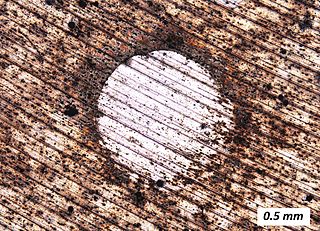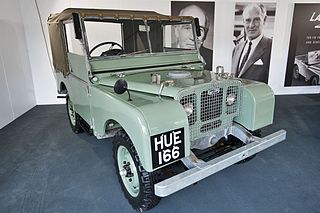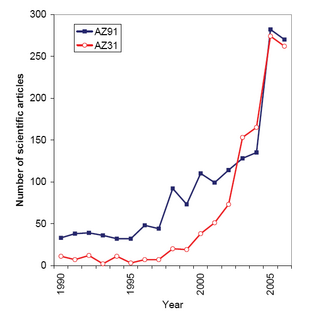Related Research Articles

An alloy is a mixture of chemical elements of which at least one is a metal. Unlike chemical compounds with metallic bases, an alloy will retain all the properties of a metal in the resulting material, such as electrical conductivity, ductility, opacity, and luster, but may have properties that differ from those of the pure metals, such as increased strength or hardness. In some cases, an alloy may reduce the overall cost of the material while preserving important properties. In other cases, the mixture imparts synergistic properties to the constituent metal elements such as corrosion resistance or mechanical strength.

Metallurgy is a domain of materials science and engineering that studies the physical and chemical behavior of metallic elements, their inter-metallic compounds, and their mixtures, which are known as alloys.

A piston is a component of reciprocating engines, reciprocating pumps, gas compressors, hydraulic cylinders and pneumatic cylinders, among other similar mechanisms. It is the moving component that is contained by a cylinder and is made gas-tight by piston rings. In an engine, its purpose is to transfer force from expanding gas in the cylinder to the crankshaft via a piston rod and/or connecting rod. In a pump, the function is reversed and force is transferred from the crankshaft to the piston for the purpose of compressing or ejecting the fluid in the cylinder. In some engines, the piston also acts as a valve by covering and uncovering ports in the cylinder.

Duralumin is a trade name for one of the earliest types of age-hardenable aluminium–copper alloys. The term is a combination of Dürener and aluminium. Its use as a trade name is obsolete. Today the term mainly refers to aluminium-copper alloys, designated as the 2000 series by the international alloy designation system (IADS), as with 2014 and 2024 alloys used in airframe fabrication.

Forging is a manufacturing process involving the shaping of metal using localized compressive forces. The blows are delivered with a hammer or a die. Forging is often classified according to the temperature at which it is performed: cold forging, warm forging, or hot forging. For the latter two, the metal is heated, usually in a forge. Forged parts can range in weight from less than a kilogram to hundreds of metric tons. Forging has been done by smiths for millennia; the traditional products were kitchenware, hardware, hand tools, edged weapons, cymbals, and jewellery.
Aluminium–silicon alloys or Silumin is a general name for a group of lightweight, high-strength aluminium alloys based on an aluminum–silicon system (AlSi) that consist predominantly of aluminum - with silicon as the quantitatively most important alloying element. Pure AlSi alloys cannot be hardened, the commonly used alloys AlSiCu and AlSiMg can be hardened. The hardening mechanism corresponds to that of AlCu and AlMgSi.

Carbon steel is a steel with carbon content from about 0.05 up to 2.1 percent by weight. The definition of carbon steel from the American Iron and Steel Institute (AISI) states:

Birmabright is a trade name of the former Birmetals Co. for various types of lightweight sheet metal in an aluminium–magnesium alloy. The alloy was introduced by the Birmid Group in 1929 and was particularly noted for its corrosion resistance. Birmal Boats was created in 1930 for the building of light-alloy boats. Birmetals Ltd was formed in 1936 and during the war produced both copper bearing aluminium alloys and the Birmabright magnesium bearing alloys, mainly for aircraft production.

Inconel is a nickel-chromium-based superalloy often utilized in extreme environments where components are subjected to high temperature, pressure or mechanical loads. Inconel alloys are oxidation- and corrosion-resistant. When heated, Inconel forms a thick, stable, passivating oxide layer protecting the surface from further attack. Inconel retains strength over a wide temperature range, attractive for high-temperature applications where aluminium and steel would succumb to creep as a result of thermally-induced crystal vacancies. Inconel's high-temperature strength is developed by solid solution strengthening or precipitation hardening, depending on the alloy.

Magnesium alloys are mixtures of magnesium with other metals, often aluminium, zinc, manganese, silicon, copper, rare earths and zirconium. Magnesium alloys have a hexagonal lattice structure, which affects the fundamental properties of these alloys. Plastic deformation of the hexagonal lattice is more complicated than in cubic latticed metals like aluminium, copper and steel; therefore, magnesium alloys are typically used as cast alloys, but research of wrought alloys has been more extensive since 2003. Cast magnesium alloys are used for many components of modern automobiles and have been used in some high-performance vehicles; die-cast magnesium is also used for camera bodies and components in lenses.
Alloy steel is steel that is alloyed with a variety of elements in total amounts between 1.0% and 50% by weight to improve its mechanical properties.

An aluminium alloy (UK/IUPAC) or aluminum alloy is an alloy in which aluminium (Al) is the predominant metal. The typical alloying elements are copper, magnesium, manganese, silicon, tin, nickel and zinc. There are two principal classifications, namely casting alloys and wrought alloys, both of which are further subdivided into the categories heat-treatable and non-heat-treatable. About 85% of aluminium is used for wrought products, for example rolled plate, foils and extrusions. Cast aluminium alloys yield cost-effective products due to the low melting point, although they generally have lower tensile strengths than wrought alloys. The most important cast aluminium alloy system is Al–Si, where the high levels of silicon (4–13%) contribute to give good casting characteristics. Aluminium alloys are widely used in engineering structures and components where light weight or corrosion resistance is required.
6061 aluminium alloy is a precipitation-hardened aluminium alloy, containing magnesium and silicon as its major alloying elements. Originally called "Alloy 61S", it was developed in 1935. It has good mechanical properties, exhibits good weldability, and is very commonly extruded. It is one of the most common alloys of aluminium for general-purpose use.

The Hiduminium alloys or R.R. alloys are a series of high-strength, high-temperature aluminium alloys, developed for aircraft use by Rolls-Royce ("RR") before World War II. They were manufactured and later developed by High Duty Alloys Ltd. The name Hi-Du-Minium is derived from that of High Duty Aluminium Alloys.
Brightray is a nickel-chromium alloy that is noted for its resistance to erosion by gas flow at high temperatures. It was used for hard-facing the exhaust valve heads and seats of petrol engines, particularly aircraft engines from the 1930s onwards. It was developed by Henry Wiggin and Co at Birmingham.
Marie Laura Violet Gayler BSc, DSc, MISI/MIM, HonMBDA was an English Metallurgist whose most notable contributions to her field were in the areas of Aluminium alloys and dental amalgams. She spent most of her career at the National Physical Laboratory, where she, along with Miss Isabel Hadfield, were the first women to be appointed as staff in the department of metallurgy.
Wallace Charles Devereux CBE was a British businessman and engineer, known for his work in producing light alloys for the aircraft industry.
2218 aluminium alloy is an alloy in the wrought aluminium-copper family. It is one of the most complex grades in the 2000 series, with at least 88.4% aluminium by weight. Unlike most other aluminium-copper alloys, 2218 is a high work-ability alloy, with relatively low for 2xxx series alloy yield strength of 255 MPa. Despite being highly alloyed, it have a good corrosion and oxidation resistance due sacrificial anode formed by magnesium inclusions, similar to marine-grade 5xxx series alloys. Although 2218 is wrought alloy, owing to granular structure it can be used in casting and been precisely machined after casting. It is easy to weld, coat, or glue.
Aluminium–copper alloys (AlCu) are aluminium alloys that consist largely of aluminium (Al) and traces of copper (Cu) as the main alloying elements. Important grades also contain additives of magnesium, iron, nickel and silicon, often manganese is also included to increase strength. The main area of application is aircraft construction. The alloys have medium to high strength and can be age hardened. They are both wrought alloy. Also available as cast alloy. Their susceptibility to corrosion and their poor weldability are disadvantageous.
References
- ↑ FJ Camm (January 1944). "Y alloy". Dictionary of Metals and Alloys (3rd ed.). p. 128.
- 1 2 3 Rollason, E.C. "Y alloy". Metallurgy for Engineers. Edward Arnold. pp. 277–279.
- ↑ FJ Camm (January 1944). "Duralumin". Dictionary of Metals and Alloys (3rd ed.). p. 42.
- 1 2 3 4 Higgins, Raymond A. (1983). "Part I: Applied Physical Metallurgy". Engineering Metallurgy (5th ed.). Hodder & Stoughton. pp. 435–438. ISBN 0-340-28524-9.
- 1 2 3 Banks, Air Commodore F.R. (Rod) (1978). I Kept No Diary. Airlife. p. 63. ISBN 0-9504543-9-7.
- ↑ Banks, I Kept No Diary, p. 69
- 1 2 Murphy, A.J. (1966). "Materials in Aircraft Structures". J. Royal Aeronautical Society. 70 (661): 117. doi:10.1017/S0001924000094021. ISSN 0368-3931.
- ↑ FJ Camm (January 1944). "Hiduminium". Dictionary of Metals and Alloys (3rd ed.). p. 58.
- ↑ FJ Camm (January 1944). "R.R. Alloys". Dictionary of Metals and Alloys (3rd ed.). p. 102.